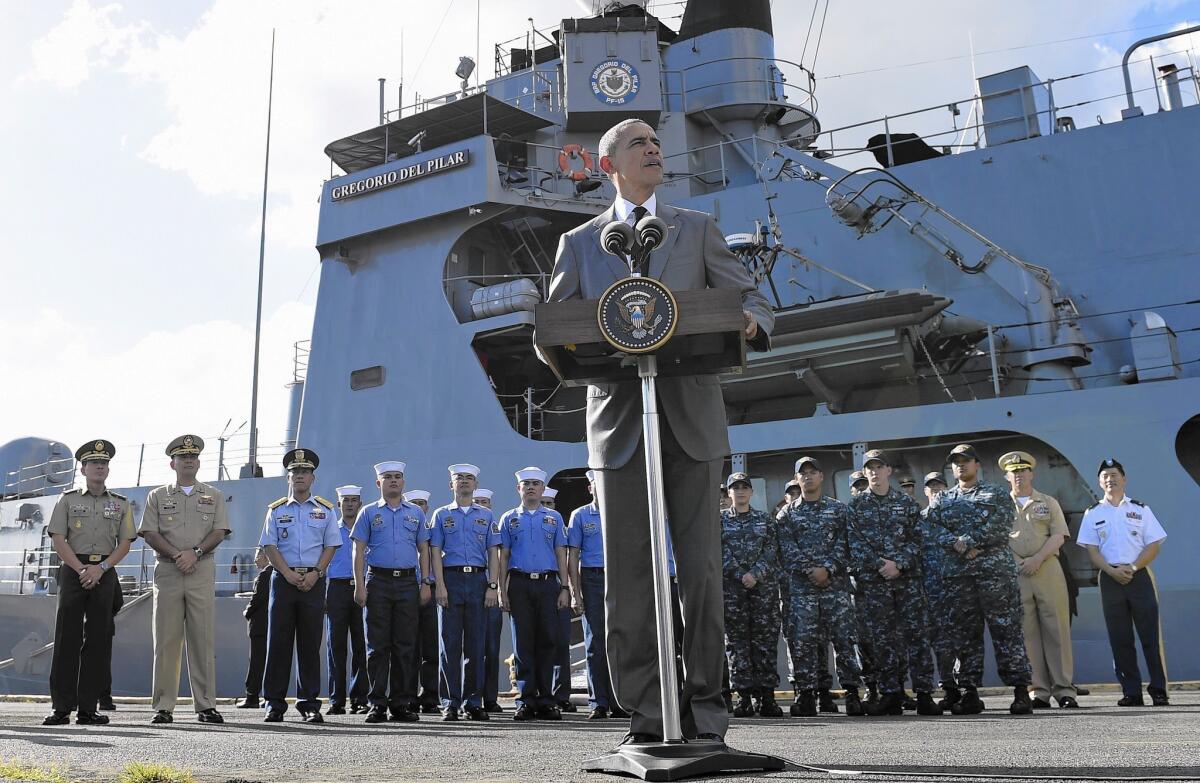Obama highlights support for the Philippines amid tension with China

President Obama speaks after touring the Gregorio del Pilar in Manila on Nov. 17, 2015. The ship is an advanced Philippine navy frigate once owned by the United States.
- Share via
Reporting from Manila — Hours after President Obama touched down in Manila on Tuesday, he toured a refurbished former U.S. frigate that is now the flagship of the Philippine navy and announced plans to give two more ships and other aid to Manila to help it patrol disputed islands in the South China Sea.
Emerging from the port side of the 378-foot ship, Obama underscored U.S. backing for a longtime Asian ally and ramped up diplomatic pressure on China, which has rattled nerves across the region by building islands on low-lying reefs and shoals and using them to bolster its claims to a vast swath of ocean.
“You can count on the United States” to help protect “the security of the waters of this region,” Obama said. “More capable navies and partnership with the United States are critical.”
The U.S. is planning to transfer to the Philippines a research vessel, the Melville, to help Manila map its vast archipelago, as well as a U.S. Coast Guard cutter, the Boutwell, to boost its small and aging navy and coast guard. The White House also announced plans to increase maritime assistance to Vietnam, Indonesia and Malaysia.
It was fresh evidence of what Obama said was a renewed commitment to the security of the region since the strategic “rebalance” toward Asia that he announced in 2011.
White House aides acknowledged that Washington is seeking to pressure China to back away from its aggressive territorial and maritime claims in the South China Sea without damaging its larger relationship with Beijing, the United States’ second-largest trading partner.
“People want to know the United States is going to be a stabilizing force” in Asia, said Ben Rhodes, Obama’s deputy national security advisor. “But they also want us to have a good relationship with China.”
Along with the attacks Friday in Paris that left 129 people dead, the tension in the South China Sea is expected to dominate the next few days at the Asia-Pacific Economic Cooperation forum, which Obama is attending. Though Obama and Chinese President Xi Jinping won’t meet here, they could do so late this month at a climate summit in Paris.
“This is not aggression toward China. It’s not an effort to contain China,” said Ernest Bower, Southeast Asia expert at the Center for Strategic and International Studies, a Washington think tank. “It’s really an effort to convince China that the status quo is going to remain in Asia, which is that the Americans are going to be a major provider of security guarantees for the Pacific.”
See the most-read stories this hour >>
The Philippine government was among the strongest supporters of U.S. action last month when the Pentagon ordered a guided-missile destroyer to patrol inside the 12-mile maritime limit that China had declared around one of the shoals it has claimed in the South China Sea. The move, designed to bolster freedom of navigation in what the U.S. regards as international water, sparked an angry condemnation from Beijing.
Although officials in the Philippines and other countries in the region generally want a larger U.S. military role as a counterbalance to China’s growing military, many are also nervous about allowing the U.S. a permanent military presence in their countries.
It has been more than a year since the U.S. and the Philippines announced an enhanced defense cooperation pact that would give the American military new access to bases here. The agreement has been stalled by a legal challenge pending before the Philippines’ Supreme Court.
Obama has sought to tamp down the military rivalry with Beijing. The White House delayed a decision for months on sending the destroyer to assert freedom of navigation, the first such operation in three years. Even after doing so, the U.S. said little publicly about the mission.
The handling of the operation appeared aimed at avoiding an open dispute with the Chinese as the Obama administration was working closely with them on other subjects, including climate issues before the summit in Paris.
The U.S. caution “has raised questions among military professionals elsewhere in the region about whether the U.S. has the stomach for what is likely to be a long-term standoff and test of wills in the South China Sea,” said Michael Green, senior vice president for Asia at the Center for Strategic and International Studies.
U.S. officials expect maritime disputes to be a major topic of discussion over the next few days as the president attends the Asia-Pacific forum here and the Assn. of Southeast Asian Nations and East Asia summits later this week in Kuala Lumpur, Malaysia.
A Chinese government official urged the U.S. to “avoid sending the wrong signals to regional countries” about the contested issue during the international meetings, the New China News Agency reported.
“Although we don’t want to see the South China Sea issue became a hot topic at the summit, it is unavoidable that some countries may take up the matter,” Vice Foreign Minister Liu Zhenmin said.
The U.S. says it remains neutral in the territorial and maritime disputes between China and its neighbors in East Asia. It has long urged China and other countries to agree on a code of conduct for resolving the disagreements over their maritime boundaries.
Speaking later Tuesday after his first meeting with Australia’s new prime minister, Malcolm Turnbull, Obama reiterated that the disputes “should be resolved by international norms and the rule of law, and peacefully so.”
The president is eager to use his visit here to highlight successes in his effort to bolster the U.S. presence in the Pacific after a decade of wars in the Middle East. On Wednesday, he will meet with the 11 other heads of government representing signatories to the newly negotiated Trans-Pacific Partnership trade pact and will discuss his goals before the climate summit.
Memoli reported from Manila and Cloud from Washington.
Twitter: @mikememoli and @DavidCloudLAT
ALSO
French investigators believe another attacker could still be at large
Obama under pressure to intensify fight against Islamic State after Paris attacks
Rand Paul drops the mic on Donald Trump over China’s participation in trade deal
More to Read
Sign up for Essential California
The most important California stories and recommendations in your inbox every morning.
You may occasionally receive promotional content from the Los Angeles Times.















